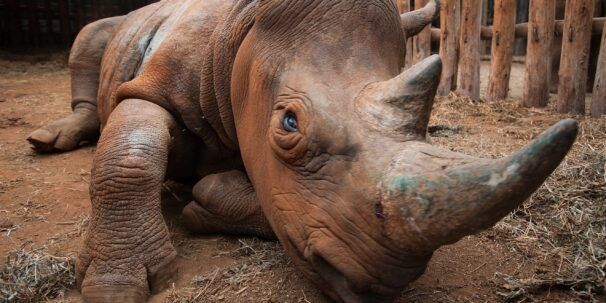What is extinction and how does it happen?
Wondering how long the human species will last? Learn about the history of mass extinctions and how we can avoid the same fate.

Extinction, like many evocative words, is bandied around a lot in the modern age — in large part by groups like Extinction Rebellion, for whom the issue is central. It’s easy to see why extinction might be a cause for concern. Depending on your perspective, it’s just about the worst thing that can possibly happen. With the loss of a species, something unique is wiped irrevocably from the face of the planet.
But is it something we need to seriously worry about as humans? What can, or should, we be doing to stop it? Here, we’ll take a closer look.
What is extinction?
A species is considered extinct when the last of its kind dies. In many cases, we decide that this has happened only years after the event, with reference to the fossil record. Sometimes a species might not be technically extinct, but its population is small enough to be unviable. For those species, the writing is sadly on the wall.
Over the history of our planet, around five billion species have become extinct — which is 99% of all life to have ever lived. This doesn’t include some species that are extinct in the wild but still persist in captivity.
The International Union for the Conservation of Nature maintains a system of ranking animals by their conservation status. Known as the ‘Red List’, it includes seven levels of concern, ranging from ‘extinct’ to ‘least concern’.
What about mass extinction?
When most people think of the word ‘extinction’, they think of something a little more cataclysmic than the usual slow process of selection. ‘Mass extinction’ is a term used when lots of different species go extinct at roughly the same time. It’s marked by a significant loss of biodiversity, which is a measure of how much life varies in form.
Extinction is contrasted with diversification, which is the process by which biodiversity rises during the period between extinctions, as the remaining lifeforms adapt to the new status quo.
You might also see mass extinction referred to as an ‘extinction level’ event. The two terms are broadly synonymous.
Extinction of marine species
Many of the more famous extinctions have been land-roaming animals. But there are also species that lived beneath the sea, whose fossilised remains may never be discovered. Marine conservation is arguably more important than any other kind, since the majority of the planet is covered by water and the oceans play a critical role in supporting land-based ecosystems.
Consequently, it’s important to understand what marine extinction looks like and how we can deal with it. This is explored in the University of the Sunshine Coast’s course on Life Below Water: Conservation, Current Issues, Possible Solutions.
If you want to fully understand extinction, then understanding how life came to be is essential. There are few better places to start than our course on Earth and Life, which is part of astrobiologist Dr Louisa Preston’s online expert track on Life on Mars, Earth and Beyond.




Extinction-level events
So, how many extinction level events have there been? Well, it’s difficult to know for sure. There’s no stark measure of how many extinctions are required for a given time period to qualify. Plus, there are still plenty of gaps in the fossil record, which means there may be other events we don’t yet know about it.
With all that aside, five or six events are widely agreed to qualify. They’re usually named after the geological eras that come before and after the events.
1. Ordovician-Silurian
This is the first of the ‘big five’ events, which wiped out an astonishing 85% of marine species. Scientists are still piecing together exactly what caused it, but we do know that it unfolded across two stages: first came a stage of mass cooling, and then there was sudden warming. Many species that had adapted to the former were blindsided by the latter, and died off suddenly.
2. Late Devonian
In the late Devonian Epoch came this extinction, which wiped out around half of all genera on Earth (genera being the plural of genus, which is one taxonomic ranking up from species). You could actually call it several different mass extinctions, striking in succession over a period of 25 million years.
3. Permian–Triassic
We can pretty comfortably call this one the worst extinction event ever. Sometimes called The Great Dying, it was probably caused by the eruption of massive volcanoes in Siberia around 252 million years ago. The oceans became highly acidic and deoxidised, and many species quickly died out.
We’ve dealt with this critical transition in our open steps on Before and After the End Permian Extinction Event, and Bringing Life to its Knees from the University of Cape Town. You can also read how have volcanic eruptions shaped our planet? by Cardiff University.
4. Triassic–Jurassic
The Triassic era ended around 201 million years ago with the extinction of roughly a third of marine life and all archosaurs (giant reptiles), except for dinosaurs, pterosaurs, and crocodiles. Its causes were broadly similar to those of the preceding event: volcanic activity destroying the oceans.
5. Cretaceous–Paleogene
This is the one that wiped out the dinosaurs (or at least, those dinosaurs that didn’t go on to become birds) along with three-quarters of all life on Earth. It was caused by a big, big asteroid. We’ll come back to it in a moment.
6. Holocene
The Holocene extinction is the one that we’re currently living through (and very likely perpetuating). It’s often called the ‘sixth’ mass extinction event, as it’s only recently that scientists have come to emphasise just how quickly things are unravelling.
We deal with the Holocene extinction in two open steps from the University of Cape Town: Our world today: Facing a sixth extinction?, and Extinctions: Present and Future.
Each of the six events is dealt with in our Extinctions: Past and Present course by the University of Cape Town. As well as teaching you about events in the past, this course will help you respond to the environmental challenges of the present.
What about the asteroid that killed the dinosaurs?
Around 65 million years ago, an asteroid struck the Yucatán peninsula, in modern Mexico. The impact released more energy than a billion atomic bombs, spread approximately 48,000 cubic miles of debris into the air, and left behind the Chicxulub crater.
Now, getting hit by an asteroid is going to ruin anyone’s day. But most of the extinction that followed wasn’t actually caused by the impact itself, but by the knock-on consequences.
Sunlight-dependent plants went into sharp decline, as the atmosphere around the world was choked with dust and smoke. The animals that did survive were those that fed on dead plants and animals. Birds, for example, ate insects, which in turn survived mostly on dead and decaying matter.
This probably isn’t even the largest asteroid to ever hit the earth. Given that the earth is around 4.5 billion years, it would be fairly astonishing for the largest ever asteroid to arrive so recently. The surface of the earth is covered with massive craters. The largest is the Vredefort Crater in South Africa, followed by the Sudbury Basin in Ontario, Canada.
You might suppose that a hundred-mile crater would be an easy thing to spot. But it was only during the early nineties that the Chicxulub was discovered. It’s been completely covered up in the intervening aeons, but you can still spot it if you dig deep enough, or find the right section of exposed rock. In the rock, you’ll see a thin, dark layer running across, called the Cretaceous-Paleogene boundary.
The boundary contains high concentrations of iridium, which likely spread over the entire planet and was buried and compressed over time. Iridium is pretty rare on Earth — but it is found on asteroids.




Human impact on the natural world
According to a report by the Intergovernmental Science-Policy Platform on Biodiversity and Ecosystem Services (or IPBES for short), the current rate of extinction is orders of magnitude higher than the usual ‘background’ rate that we’ve been through for the past 10 million years.
You might think that all of this is synonymous with climate change. But habitat loss driven by human activity is a colossal problem even if we disregard the effect that climate change is having.
War and conflict can also be highly disruptive to the natural world. This is dealt with in our Environmental Challenges: Scarcity and Conflict in the Natural Environment course by the University of Leeds. Of course, climate change also feeds into extinction. The University of Reading and the Walker Institute deal with this in their course: Planet Partners: Tackling the Climate Crisis Together.
How do we know humans are causing extinction?
The Holocene era has seen a significant uptick in extinction. But can we be sure that these recent extinctions have been caused by human activity, rather than coinciding with it?
The history of human impact on other species
There’s plenty of reason to pin the blame on human beings. When the first settlers to Australia arrived, around 45 thousand years ago, the continent was teeming with massive animals, called ‘megafauna’. We’re talking wombats the size of grizzly bears, five-metre snakes, and marsupial lions. 90% of these animals became extinct within a thousand years of humankind’s arrival. Many of these animals are studied at the University of Wollongong in Australia, whose open step on faunal remains is worth looking at.
When separate Māori settlers spread to New Zealand, the same thing happened there. Human beings arrived, and all other life took a sharp turn downward. Today, Te Ao Māori (that’s the Māori worldview) has a great deal to say about sustainability, which is laid out in our course on Solving Sustainability Challenges with Te Ao Māori by the Waikato Institute of Technology and TePūkenga New Zealand.
We see a similar story in the case of the Earth’s last remaining woolly mammoths, which lived on Wrangel Island in the Arctic Sea, until — unbelievably — as recently as around 2,000 BC. Human beings arrived on the island at around the same time. The dodo, too, was endemic to its home island of Mauritius, until Dutch sailors arrived at the turn of the 17th century. Shortly thereafter, they were hunted to extinction.
Human impact on different species today
It’s a similar story for many modern animals, like the Orangutan, the Black Rhino and the Yangtze Finless Porpoise, all of which are considered ‘Critically Endangered’ by WWF. Larger animals are more vulnerable to sudden changes in their environment. They reproduce more slowly and their populations are smaller. If Orangutans bred more like rabbits, then their decline might well have been less precipitous.
Even when we aren’t simply hunting animals directly, we can still outcompete them for scarce resources like land and food. For example, think of a stretch of rainforest being hacked down to make way for a monoculture like soy, which is being used predominantly to feed livestock. It’s partly for this reason that eating a plant-based diet is now so widely recommended.
The ways in which interconnected ecosystems can be affected by small changes are explored by Professor Lindsey Gillson at the University of Cape Town in two open steps on ecosystem pressures and the recovery of ecosystems.
When will humans go extinct?
The scale of all of this extinction may strike you as a boundless tragedy in and of itself, but there’s a clear danger that human beings might find themselves on the red list.
Existential risk comes in many different forms. Nuclear annihilation is a possibility that’s looking more plausible than it has since the height of the cold war. Then there’s the likelihood that we’ll be struck by another asteroid, or that a mega-volcano will erupt, catastrophically altering the climate.
Human beings have already come close to extinction several times — and we’ve actually grown extremely quickly, compared to other species. This is good news for us, but bad news for our genetic diversity, and our rates of fertility.
What should really concern us is the ability of the natural world to sustain the burden we’re placing on it. Nature is hugely interconnected in ways that we’re still just beginning to understand. Sometimes, the small things we do can have an outsized impact. The University of Exeter’s course on Invisible Worlds: Understanding the Natural Environment is a great place to deepen your understanding of these things.
Of particular importance are pollinators, which play a crucial role in a whole range of crucial processes necessary for an ecosystem to function. This is covered in the University of Cape Town’s course on plant and insect diversification.
What can be done?
Extinction Rebellion is an example of a group that’s succeeded in banging the drum for the environment. They’ve garnered attention for themselves and for their cause. Whether this translates to changes in consumption or voting behaviour is to be seen. Other groups, like Just Stop Oil, and Insulate Britain, have adopted the same tactics, and garnered media attention of their own.
It’s easy to be cynical about groups like this, and what they can realistically achieve. They might be accused of preaching to the choir, vacuous posturing, or even terrorism.
But there’s reason to suppose that the tactics might be effective in persuading some. When Extinction Rebellion’s protests first started capturing the public’s attention in 2019, we saw a sharp uptick in concern about the environment, with around a quarter of Britons ranking it as one of the UK’s three most pressing concerns. Among 18–24 year-olds, the figure was much higher. Whether you attribute this to Extinction Rebellion, David Attenborough, or a much broader generational shift, the direction of travel is clear.
We’ve already blogged about the practical steps you might take to reverse the trend toward extinction in Save the planet: 6 ways you can prevent animal extinction. Most of our tips centre around your consumption habits. You might also donate to effective charities, write to your MP, and generally make yourself better informed on the issue so that you can pass the information on to your peers.
Thanks to the modern internet, it’s never been easier to get access to information. Unfortunately, misinformation is just as accessible. For quality resources on this issue and others, FutureLearn is a great place to look.
The University of Leeds’ course on Ecology and Wildlife Conservation is ranked by Class Central as one of the best online courses of all time, so it could be a great place to start.
Final thoughts
Tragic though it may be, extinction is inevitable. Some of the branches in Darwin’s famous tree of life have to come to an end in order for others to have the space to spread. If they didn’t, there would be no process of selection, and life as we know it would not be possible. If the dinosaurs had avoided their fate, then the natural world we know and cherish today would never have come to be.
As we’ve come to understand more about the patterns of extinction on planet Earth, we’ve been led toward the startling conclusion that human activity is driving extinction in a way that’s unprecedented and potentially disastrous. What we do in response to this realisation may have enormous consequences — but it remains to be seen whether we’ll rise to the challenge.








